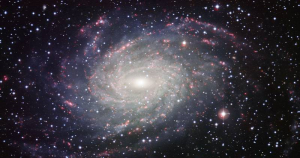
Indian-origin Professor Develops New Method For Hunting Dark Matter
A recent study found that the dark matter in dwarf galaxies is distributed smoothly rather than being clumped at their centers, which contradicts simulations using the standard cosmological model. An Indian-American professor has devised a new method to characterize dark matter that can help hunt for the mysterious space phenomenon.
This new method to characterise dark matter marks the first real application of the field of galacto-seismology. Sukanya Chakrabarti, assistant professor at Rochester Institute of Technology in New York says, “Invisible particles known as dark matter make up 85 percent of the mass of the universe. Where it concentrates, normal matter – mostly gas – congregates and condenses into stars and galaxies that can be seen. However, the method for locating satellite galaxies dominated by dark matter taps into principles used in seismology to explore the interior of the galaxy.”
Chakrabarti used the waves in the galactic disk to map the interior structure and mass of galaxies – like seismologists analyze waves travelling through the earth to infer properties about the Earth’s interior.
The team used the spectroscopic interpretations for estimating the speed of the Cepheid variables that is a trio of pulsating stars used as yardsticks for measuring the distance in galaxies in the Norma constellation.
Chakrabarti used Cepheid variables to mark the location of a dark-matter dominated dwarf galaxy approximately 300,000 light years away. In contrast, the disk of the Milky Way terminates at 48,000 light years.
Using spectroscopic analysis, they were able to show that the stars also have about the same velocity and that they are moving too fast to be part of our galaxy. They are racing away from their home galaxy at 450,000 miles per hour, whereas the average Milky Way star has a radial velocity of only about 25,000 miles per hour. Lying in a dwarf about 300,000 miles away from the Milky Way, the stars are a part of an organized, swiftly running system.
“The radial velocity of the Cepheid variables is the last piece of evidence that we’ve been looking for”, she said and added that “they are not part of our galaxy”. “You can immediately conclude that they are not part of our galaxy”.
The study questions the standard paradigm that the old stars populate the dark matter halo and young stars form in the stellar disks that are rich in gas.
Led by former UC Berkeley postdoctoral fellow Sukanya Chakrabarti, now an assistant professor of astronomy at the Rochester Institute of Technology, and her UC Berkeley mentor, Leo Blitz, a professor of astronomy, the research was presented in the American Astronomical Society meeting in Kissimmee that has been submitted to Astrophysical Journal Letters.